Angara launch facility in Plesetsk (original) (raw)
Processing facility for Angara payloads
Angara pad in Vostochny in 2018
Angara pad in Vostochny in 2019
Searching for details:
The author of this page will appreciate comments, corrections and imagery related to the subject. Please contact Anatoly Zak.
Angara launch complex in Plesetsk
The Russian military built the primary launch complex for the Angara rocket in Plesetsk, at the site originally intended for the Zenit rocket. The construction of the Zenit launch pad stalled during the first half of the 1990s, and the idea of bringing Zenit to Plesetsk was abandoned altogether due to Russia's financial woes and complex relations with Ukraine, where Zenit was built. During the 1990s, another launch complex for the Angara was also considered for Svobodny Cosmodrome in the Russian Far East, however, the level of funding of the Russian space program at the time left these plans on paper. A scheme of building a commercially operated Angara launch site on the Australia's Christmas Island in the Indian Ocean near the Equator was under consideration, again without any real progress "in the field."
Previous chapter: Plesetsk facilities
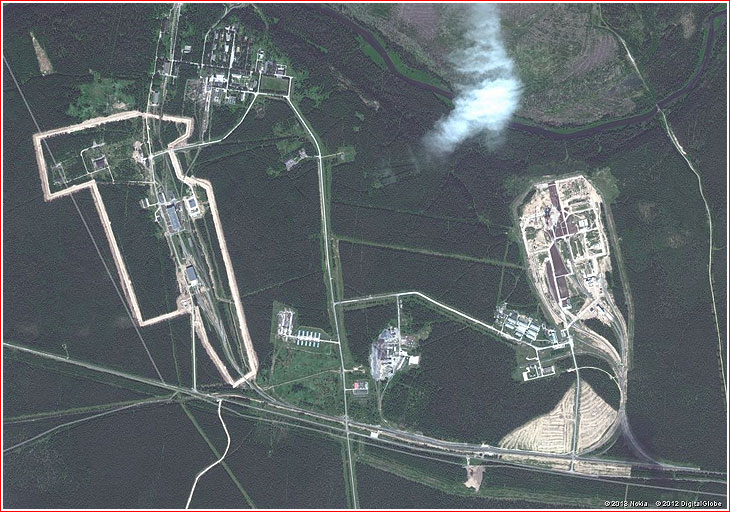
A satellite image of the processing complex (left) (Insider Content) and the launch pad for the Angara rocket in Plesetsk.
Origin of the facility
In 1976, Soviet government officially approved the deployment of the next-generation Zenit rocket at the country's northern launch site in Plesetsk. The main contractor for the project, a Moscow-based KBTM design bureau, actively lobbied an immediate start of the construction in Plesetsk, even though its leaders could not anticipate the collapse of the USSR 15 years later. In any case, the Kremlin gave priority to Zenit's pad in Baikonur in Kazakhstan. Only in 1982, after a series of surveys at the northern site, KBTM developed specifications for adapting Zenit's launch infrastructure for the requirements of the Defense Ministry in Plesetsk.
The Plesetsk-based complex was designed to accommodate a two-stage Zenit-2 and its three-stage version -- Zenit-3, which required five new facilities, comparing to the original launch complex in Baikonur. From Plesetsk, Zenit could send newest Soviet military satellites into high-inclination orbits, possibly including heavy reconnaissance spacecraft planned at the time carrying from 16 to 24 reentry capsules with film. The rocket probably could also launch manned Soyuz spacecraft and its successors toward the future space station deployed in the near-polar orbit!
The Zenit's launch pad in Plesetsk, under designation 11P877, was to be located at Site 35 (also previously known as 41st kilometer) and its processing complex -- 11P577 -- would be built three kilometers away, at Site 142, using some refurbished and some new buildings. The construction was scheduled to take place from 1986 to 1992. By the time the Soviet economy began crumbling at the end of the 1980s, up to 95 percent of the equipment for Zenit's launch complex had already been manufactured and delivered to Plesetsk. The collapse of the USSR pushed the completion date for the facility to 1996, however after spending 70 percent of funds originally allocated for the task, the Ministry of Defense froze the construction in 1992 and then gave up on the whole idea of bringing Zenit to Plesetsk. (114)
The launch platform for the Zenit rocket was eventually shipped from Plesetsk to Baikonur for a planned restoration of the PU-2 launch pad at the Zenit launch facility, which had been destroyed in a failed launch in 1990. However this effort was also abandoned and the platform made another trip across the country to the port of Vyborg near St. Petersburg, where it was refurbished for the installation on the Sea Launch platform.
The formal government decision to discontinue the effort to bring Zenit to Plesetsk was not taken until Feb. 1, 2000. (728)
Switching to Angara
In the meantime, in 1992, the KBTM began developing a proposal and the preliminary design of the launch facilities for the Angara program. The project envisioned maximum use of existing infrastructure in Plesetsk, first of all the unfinished Zenit pad. A dual-pad Versatile Launch Complex, USK, designated 14P221, could be used for all versions of the Angara rocket. Specifically for the heavyweight Angara-2T launcher, KBTM developed a process of vertical assembly, not typical for the Russian rocket technology.
In the initial stage of development, the launch complex was reportedly designed to feature a special interface structure on the side of the rocket, which enabled fueling and drainage of all stages of the launch vehicle, including those loaded with liquid hydrogen. The idea was eventually dropped.
Overall, two versatile launch pads were to be built in Plesetsk and both would be capable capable of supporting the entire family of Angara rockets! At least at some point, a universal facility capable of hosting the Zenit and Angara rockets was under consideration.
Developments in the 2000s
The work in Plesetsk remained stalled during the 1990s, but started picking up in 2001. During a meeting in November 2001, officials from the Ministry of Defense, Space Forces, Rosaviakosmos and GKNPTs Khrunichev made a new commitment to development of the launch infrastructure of the Angara in Plesetsk beginning in 2002.
Given the terrible financial situation, it was decided as the first step to build a single "bare-bone" launch pad capable of supporting the suborbital flight of the light-weight Angara-1.1 rocket in 2005. The support infrastructure was reduced to the absolute minimum, even fueling of the rocket with oxygen was expected to be performed from a railway cistern, any excess propellant would be burned right at the site and no thermal conditioning of the rocket would be provided!
The first check for 82 million 600 thousand rubles was finally issued in December of the same year. However even the entire 196.6-million-ruble budget allocated for the facility in 2002 was far not enough for the completion of the pad for the scheduled first launch of Angara-1 in 2003. Moreover, the oversight of the industry over the project was lacking and the budgetary and technical planning was also inadequate. Since even the most streamlined launch complex for the Angara turned out to be unaffordable, the project managers entertained the idea of converting Soyuz pad at Site 16 or the Tsyklon-3 pad at Site 32 for the first Angara launches. All these plans and deadlines were eventually dropped in favor of long-term construction of the Angara-5 launch pad.
On the organizational side of the project, the 50th laboratory, which on paper was still responsible for the development of the Zenit launch complex, was formally re-assigned to the Angara project in 2001. In 2002, this unit was officially named the 5th Department of launch equipment and testing of the Angara system. In 2003, Test Group 1 dedicated to the testing and operational use of the Angara rocket was also formed in Plesetsk.
At the end of 2003, survey teams from GKNPTs Khrunichev and TsSKB Progress, whose classified satellites were expected to ride Angara into orbit, reviewed the latest state of existing processing facilities in Plesetsk. After some debate, they accepted proposals from the launch site leadership about the revival of the infrastructure for the purposes of the Angara project. The processing building, which was previously used for the preparation of Yantar spy satellites, would be converted into all-purpose processing center for Angara's payloads. The rocket's KVRB hydrogen stage would also be processed within the same complex. (597)
On Nov. 17, 2004, the Russian government approved a new launch site development program aimed to make Russia independent in space launches from Kazakhstan. From 85 to 90 percent of the program's budget was allocated for the development of the launch pad for the Angara-5 rocket in Plesetsk.
Also in 2004, the Zvezdochka shipyard in Severodvinsk started development of a launch platform for the Angara's pad in Plesetsk. It was officially completed on Oct. 9, 2005. The structure then had to be disassembled for shipment by rail. According to Lt. General Anatoly Bashlakov, the head of Plesetsk Cosmodrome, at the end of July 2006, a giant launch platform 14 meters wide and more than five meters high was delivered to Plesetsk. The structure was made out of 16 segments, each weighing from 20 to 50 tons. In June 2005, Khrunichev's representative said that the launch complex for the Angara was 80 percent ready, the state had finally provided funds and the construction was going on at full steam.
In August 2006, a Russian press quoted Bashlakov as saying that flight tests of the light version of the Angara booster would start in 2010-2011. During 2006, 1.5 billion rubles were spent on the Angara facility in Plesetsk. By that time, construction workers started internal outfitting of key facilities of the Angara complex. (597) The 2010-2011 deadline became an official line for Roskosmos during 2007. On December 13, 2007, the commander of the Russian space forces, Vladimir Popovkin told the Russian press that all development work during that year had been completed successfully and the project remained on schedule for the first test launch at the end of 2010. According to Popovkin, the launch complex for the Angara rocket was 60 percent completed after spending 900 million rubles. Launch hardware started arriving to the pad and its installation was initiated.
In August 2008, the Krasnaya Zvezda newspaper, the mouthpiece of the Defense Ministry, reported that at the time, construction workers were conducting assembly of two pieces of the launch platform with a mass of 350 tons each. Around 700 tons of metal was to be used to build the complex, including its thermal resistant layer covering the main flame duct.
At the time, 1,000 specialists and 100 units of machinery worked at the site daily. The newspaper quoted Colonel Oleg Pivovarov, the head of the Plesetsk directorate of the Spetstroi organization, the main contractor at the site, as saying that the pad construction work was approaching a finish line and the installation of the launch pad equipment would start soon.
At the beginning of 2008, military and the industry publicly clashed on the pre-launch processing of the Angara rocket. Official Russian press quoted the Commander of the Russian space forces, Colonel-General Vladimir Popovkin, insisting that the on-pad time for the Angara rocket was cut from seven to four days. Speaking at the press-conference on January 31, Popovkin said that such operations as the fueling of the upper stage and a number of tests should've been moved from the launch pad to the processing building.
By the end of 2008, Zvezdochka shipyard started the construction of the versatile stand for the assembly of the payload section of the Angara rocket with the Briz upper stage. The work was completed at the beginning of 2010, to be followed by the construction of a fueling gantry for the launch pad and the transporter-erector for the rocket. These contracts were to be completed by the end of 2010. (372)
More money problems for launch facility
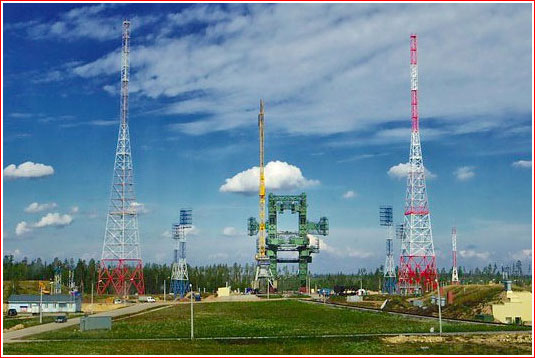
Launch pad for the Angara rocket in Plesetsk circa 2013. Credit: Spetsstroi
In the meantime in March 2009, Director General of Khrunichev enterprise Vladimir Nesterov told RIA Novosti that his company would need additional three billion rubles in the second and third quarter of 2009 in order to deliver the first Angara rockets to Plesetsk in 2010 and launch them in 2011. Additional 5.7 billion rubles would be needed in 2010 and 1.4 billion in 2011, Nesterov said. As Nesterov explained journalists in a July 19, 2010, press-conference, original contracts for the procurement of launch equipment used inflation rates of the Ministry of Defense, which were significantly lower than inflation rates used by Ministry of Economic Development and Trade, MERT. In turn, MERT rates were also below actual inflation, leading to severe underestimates in the price tag of the launch facility. As a result of the budget deficit, the company was not able to place orders for a portion of the launch hardware. By the middle of 2010, the Russian government decreed to provide additional money, however the amendment disbursing the funds was yet to clear the Duma (parliament) hearings. According to Nesterov, 2.5 years would be required from the arrival of additional money to the completion of the launch complex, thus pushing Angara's maiden mission to the beginning of 2013.
In an interview with the ITAR-TASS news agency in August 2014, the head of GKNPTs Khrunichev Vladimir Nesterov said that during 2009 and 2010, the funding for the project had been cut to one third of the planned level. A number of construction workers at the launch complex had fallen from 2,000 to just 150 people, Nesterov said.
Nesterov's interviews echoed a statement by the head of the Angara program at Khrunichev enterprise, Gennady Kleimenov. In February 2009, he told the official Russian media that all funding problems of the Angara's launch complex had been resolved, however, as he put it, "it would not be possible to built the launch facility out of banknotes." The launch hardware was yet to be manufactured, supplied and installed, Kleimenov said.
According to Kleimenov, the construction of the second launch pad for Angara could start in four years, money provided. Despite the preliminary design of the Angara launch facilities called for two launch pads, the funding available up to that time has covered a single pad only. (During President Vladimir Putin's visit to Vostochny at the beginning of September 2014, the head of the Roskosmos head Oleg Ostapenko publicly proposed to cut the money originally allocated for Angara's backup launch pads in Plesetsk and in Vostochny, in order to pay for the super-heavy launcher program.)
Nevertheless by the end of 2010, general Abroskin, the head of Spetstroi, the prime developer of the site, said that construction was entering final phases and the launch pad and at the processing complex for the Angara rocket. According to Abroskin engineering hardware was in process of installation at all key facilities of the complex. Testing work had started at some parts of the complex. (445)
In March 2011, a press-release of GKNPTs Khrunichev said that manufacturing, delivery and installation of technical systems for the processing and launch complex of the Angara rocket in Plesetsk was underway. On April 13, 2011, the head of Roskosmos, Anatoly Perminov told the Federation Council that by the end of the year 100 percent of hardware for the processing complex and 80 percent of systems for the launch complex of the Angara rocket would be delivered to Plesetsk. (470) Four months later, on August 25, Vechaslav Zelenov, the head of USS 35 branch of Spetstroi, the prime contractor for the complex construction, told journalists that the pad would be completed as scheduled by the first quarter of 2013. He did say about minor delays in supplies of technical hardware, but expressed confidence that all delays could be made up for the on-time completion of the site. According to Zelenov, the entire amount of 1.5 billion rubles allocated for the construction in 2010 had been spent and additional 780 million had been expended by August 1, 2011. Zelenov promised to complete the construction of all pre-launch processing facilities for the Angara rocket in 2011. (511)
By April 13, 2012, Zvezdochka shipyard in Severodvinsk completed factory tests of the first of two mobile erectors, which was designed for transportation and the installation of the Angara-1 rocket from horizontal into vertical position on its launch pad in Plesetsk. The 197-ton mechanism went through trials carrying a special truss, which imitated the mass of the rocket. Anticipated wind loads were also represented during tests by special cables, which resisted the movement of the erector. Following the tests of the first erector, Zvezdochka planned similar trials of the 400-ton version of the mechanism, which was designed for the Angara-5 vehicle. The same organization was also responsible for the development of the fueling tower, which had been under construction in Plesetsk at the time.
On May 23, GKNPTs Khrunichev announced that preparations had been underway to ship a "test-stand" prototype of the Angara rocket to Plesetsk. The test article would be used to certify Angara's processing and launch infrastructure and confirm the facility's operational readiness. The announcement also claimed that integrated tests of the flight control instruments and testing of software and algorithms for the rocket had been completed. Onboard equipment had also been tested. Even more doubtful claim said that systems of processing and launch complex had been manufactured and installed.
A new bit of information on the status of the project came in September 2012, when the chief of Plesetsk cosmodrome Aleksandr Golovko told the Rossiya 24 TV channel that the development of the processing infrastructure for the Angara had been almost completed and the integrated testing of the Angara-A1 vehicle was scheduled to be conducted before the end of 2012. He added that tests of individual systems and the installation of hardware had been conducted in the final phases of the project.
As of November 2013, the consruction of the launch complex in Plesetsk was six months behind schedule, the head of GKNPTs Khrunichev said in 2014.
The construction of the Angara pad in Plesetsk completed
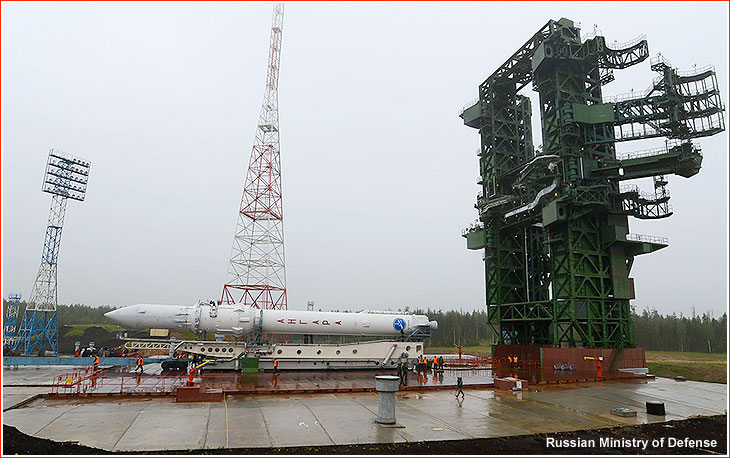
Launch pad for the Angara rocket in Plesetsk on June 25, 2014.
At the beginning of 2014, autonomous tests of various components at the Angara launch facility in Plesetsk were planned for February of that year, followed by an integrated test of all systems at once in March and April 2014. The successful completion of integrated testing would clear the way for the first launch of the Angara rocket, the official Interfax news agency reported.
As of 2014, the launch processing of the Angara rockets in Plesetsk was apparently conducted by the 2nd Center for Testing and Operation of Space Assets.
The first launch from the facility took place on July 9, 2014, when the Angara-1.2PP rocket flew a suborbital mission.
Second Angara pad in Plesetsk
Following the successful launch of Angara-1.2PP in July 2014, the Interfax news agency quoted an unnamed source at the Air and Space Defense Forces, VKS, as saying that the second launch pad for the Angara rocket would be completed in Plesetsk by 2020. The launch center would also be equipped with infrastructure to support a new "oxygen" upper stage, referring either to the Block DM-03 or KVTK space tugs.
In November 2014, RIA Novosti quoted an unnamed Russian space official as saying that the construction of the second Angara pad in Plesetsk would begin "after 2016." A budget to fund the construction was reportedly requested within Roskosmos' 10-year space program starting in 2016. In the middle of 2016, the Spetsstroi military construction agency apparently floated semi-official reports that the construction of the second Angara pad in Plesetsk could be completed as early as 2019, even though such a date sounded highly unrealistic.
As of 2017, the plans to build the second launch pad for the Angara rockets in Plesetsk had apparently been dropped, however, in August 2022, the Deputy Minister of Defense Timur Ivanov announced that the second pad for Angara in Plesetsk had been scheduled for construction before 2025 and it would support up to five launches annually.
Plesetsk upgrades hint at the second Angara-5 launch
In an effort to replace the Briz-M upper stage with the Block DM-03 space tug on the Angara-5 rocket, the Ministry of Defense planned to build necessary infrastructure in Plesetsk. One crucial facility to enable Block DM-03 operations would be the liquid oxygen fueling system, abbreviated in Russian as SZZhK. On June 6, 2018, the Chief Military Construction Directorate No. 15, FGUP GVSU-15, issued a contract worth 59.7 million rubles ($0.9 million) for the construction of the SZZhK system at the only existing launch pad for the Angara family in Plesetsk, PU-1. It was the third phase in the upgrade of the Angara launch complex in Plesetsk, accommodating 14S48 and 14S49 variants of the Block DM-03 stage.
The same contract also covered first and second phases in the upgrades of the assembly and testing complex at Facilities No. 201, and No. 309 at Site 141 in Plesetsk to accommodate components of the 14K032 space system. That part of the work included laying out internal engineering networks and the completion tests at the upgraded facilities.
On Sept. 10, 2018, the military construction directorate assigned OOO PetroVent based in St. Petersburg to upgrade the pad with the oxygen fueling system. In the documentation released with the contract, GVSU-15 characterized the work as highly urgent, which was used as a justification for skipping the required tender process and awarding the work to a single developer. The Unified Procurement Commission, EZK, approved the move on Sept. 5, 2018.
The work covered by the contract had to be completed by April 30, 2019, and the formal acceptance would be signed on May 10, 2019. It appeared that the project aimed to meet the schedule of the second mission of the Angara-5 rocket from Plesetsk.
During a visit of the Russian Minister of Defense Sergei Shoigu to Plesetsk in November 2020, Col. General Sergei Surovkin, the Supreme Commander of the Russian Air and Space Forces said that an integrated technical complex, UTP, for the Angara's payloads would be ready at the center by the end of 2021. Simultaneously, Russian TV showed what appeared to be largely completed processing buildings at the site.
Angara's launch pad
Traditionally for the Soviet and Russian rocketry, the Angara is assembled in horizontal position inside the processing building, MIK, and then delivered to the launch pad by rail on a special transporter-erector. A trip lasts for around two hours. A diesel locomotive brings the rocket to the launch facility, however last four meters the transporter moves under its own electric power to precisely position the rocket over the launch pad. The device then used to install the rocket into vertical position onto the launch pad. A locomotive then tows the empty transporter away from the pad. Two different transporters were built to transport Angara-1 and Angara-5.
The Angara's launch pad features a stationary service tower equipped with movable access arms. A single flame trench below the pad facilitates the flow of exhaust gas from the main engine of the first stage at liftoff.
According to the Red Star newspaper, a large portion of the launch facility is located underground as deep as 27 meters. The main launch control blockhouse is located 15 meters below the surface, protected by 1.5 meters of concrete and layers of sand. The launch team servicing the facility reaches around 250 people.
According to the Russian Ministry of Defense, the Angara launch complex features 211 underground and semi-underground buildings and facilities, which are interconnected with a system of fortified passageways with a total length from 4.5 to 5 kilometers. The network of various communications lines at the complex reaches 22 kilometers.
According to Spetsstroi, the main development contractor on the launch complex, its units built 180 ground facilities and installed 36 technical systems for the Angara in Plesetsk.
Known specifications of the Angara launch pad USK 14P221 in Vostochny:
| Estimated cost of the launch hardware | 0.98 billion rubles |
|---|---|
| Total hardware mass | 3,250 tons |
| Launch platform mass | 1,185 tons |
| Umbilical and fueling gantry | 1,700 tons |
| Briz-M-payload section assembly stand | more than 40 tons |
| Transporter-erector for Angara-1 rockets | 197 tons |
| Transporter-erector for Angara-5 rockets | 400 tons |
Known hardware components for the Angara's launch pad and pre-launch processing complex:
| Designation | Component description | Development status |
|---|---|---|
| 14I325 | Launch vehicle holding truss | - |
| 14I034 | Railway transporter for a component of the Angara launch vehicle within the pre-launch processing complex | - |
| 14I730 | Mass mockup of the Angara-1 rocket | - |
| 14I036-01 | Railway transporter for a component of the Angara launch vehicle within the pre-launch processing complex | - |
| 14I036-02 | Railway transporter for a component of the Angara launch vehicle within the pre-launch processing complex | - |
| 14I036-03 | Railway transporter for a component of the Angara launch vehicle within the processing complex | - |
| 14T145 | A railway transporter for the Angara-1's first stage | As of August 2012, one item was built at Tver wagon-building plant |
| 14T146 | A railway transporter for the Angara-1's second stage | As of 2010, one item was built at Tver wagon-building plant |
| 14T147 | A railway transporter for the Angara-5's strap-on booster | As of 2010, four items (for each booster) were built at Tver wagon-building plant |
| 14T149 | A railway transporter for the third stage and an adapter | As of 2010, one item was built at Tver wagon-building plant |
| 14T150 | A railway transporter for the halves of payload fairing | As of 2010, two items (for half of the fairing) were built at Tver wagon-building plant |
| 14T529 | Transporter-erector for the Angara-1 rocket | As of October 2012, underwent factory tests with a light rocket mockup |
| 14T530 | Transporter-erector for the Angara-5 rocket | As of October 2012 was undergoing tests with a heavy mockup of the launch vehicle |
Full list of launches from Site 35 in Plesetsk:
| | Launch date | Variant | Payload | Notes | | | ------------------ | ----------------------------------------------------------------------------- | ----------------------------------------------------------------------------------------------- | ------------------------------------------------ | -------------------------- | | 1 | 2014 June 27 | Angara-1PP | Mass simulator | Suborbital flight, success | | 2 | 2014 Dec. 23 | Angara-5 No. 71751/Briz-M | Mass simulator | Possible upper stage issue | | 3 | 2020 Dec. 14 | Angara-5 No. 71752/Briz-M | Mass simulator | Success | | 4 | 2021 Dec. 27 (IC) | Angara-5 No. 71753/Persei (IC) | Mass simulator | Failure of the upper stage | | 5 | 2022 April 29 | Angara-1.2 No. 71602/AM | Kosmos-2555, MKA | Success | | 6 | 2022 Oct. 15 (IC) | Angara-1.2 No. 71603/AM | Kosmos-2560, MKA-EO | Success | | 7 | 2024 Sept. 17 | Angara-1.2 No. 71604 | Kosmos-2577, Kosmos-2578 | Success |
Next chapter: Processing Complex for the Angara rocket in Plesetsk (INSIDER CONTENT)
Written by Anatoly Zak; Last update:October 29, 2024
All rights reserved
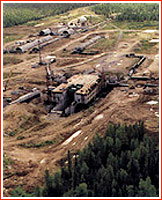
An aerial view of the unfinished Zenit launch pad in Plesetsk circa 1991. Credit: VKS
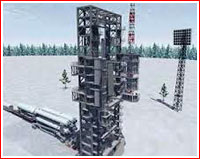
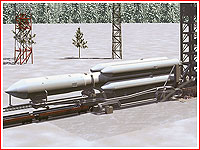
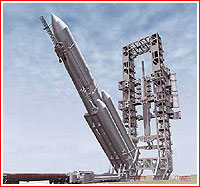
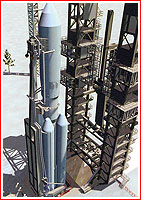
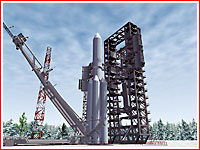
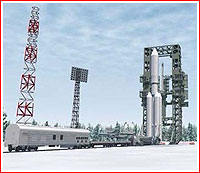
Artist renderings depicting the rollout and installation of the Angara-5 rocket on its launch pad in Plesetsk. Credit: TsENKI/GKNPTs Khrunichev
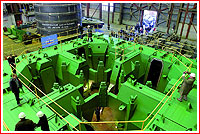
The launch platform for the Angara rocket soon after the completion of its initial assembly at the manufacturer's plant circa 2007.
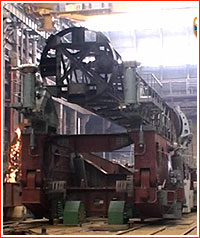
The mobile erector for the Angara-1 rocket undergoes testing at Zvezdochka shipyard in the first half of 2012 with the 14I730 light mockup of the Angara rocket simulating electric systems of the actual rocket. Credit: Zvezdochka
Main service gantry of the Angara pad in Plesetsk under construction in April 2013. Click to enlarge. Credit: Russian Ministry of Defense
The Angara pad in Plesetsk under construction at the beginning of June 2013. Click to enlarge. Click to enlarge. Credit: Spetsstroi
A view of the Angara pad from the propellant storage area. Click to enlarge. Credit: Spetsstroi
View from the top of the service tower at the Angara launch pad in Plesetsk, probably in November 2013. Credit: TsENKI
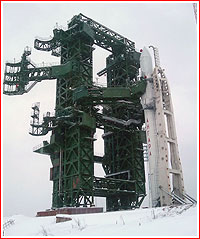
A prototype of the Angara-1.2PP rocket during integrated tests on the launch pad in Plesetsk. Credit: GKNPTs Khrunichev
A renovated assembly building at Site 142 in Plesetsk during the rollout of the Angara-1.2PP rocket on June 25, 2014. Click to enlarge. Credit: Russian Ministry of Defense
A transporter-erector with the Angara-1.2 rocket rolls to the launch pad on June 25, 2014. Click to enlarge. Credit: Russian Ministry of Defense
Angara-1.2PP rocket shortly after its installation on the launch pad in Plesetsk on June 25, 2014. Credit: Russian Ministry of Defense
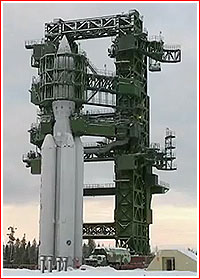
The first Angara-5 rocket on the launch pad in Plesetsk in December 2014. Credit: Russian Ministry of Defense


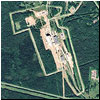
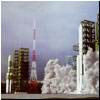
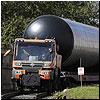


)
)
)
)
)
)
)